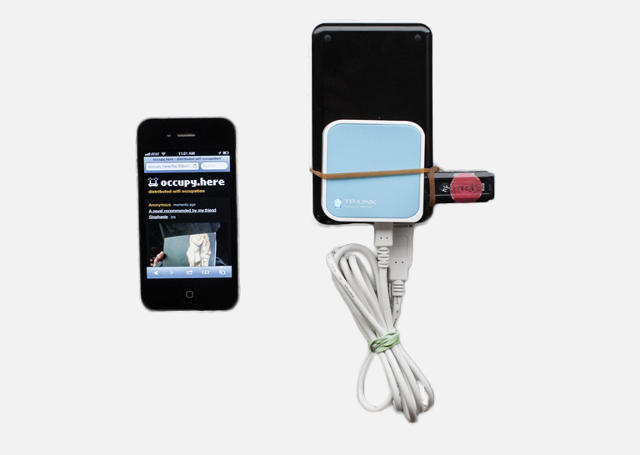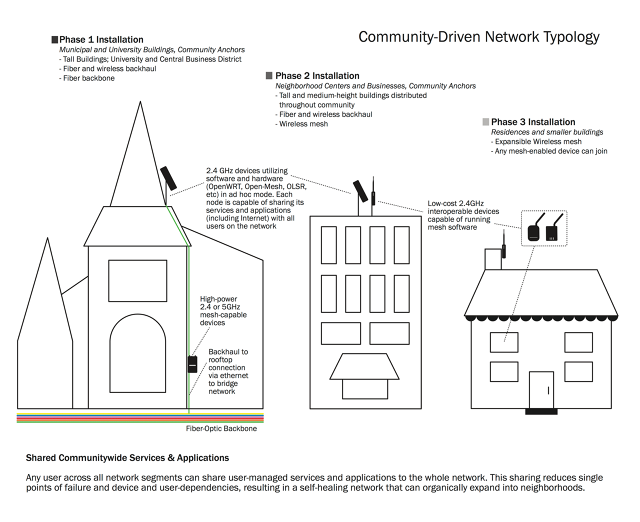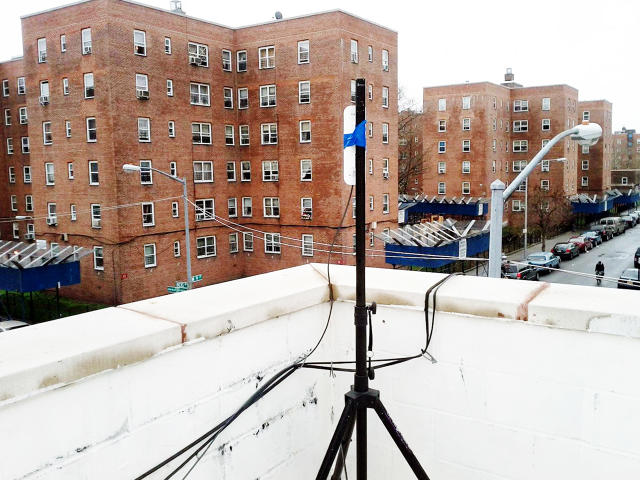Recently, a pair of artists in New York put forward an unusual plan for teaching middle school students about the Internet: specifically, by teaching them how to get off it and build their own.
The plan will combine two series of lessons: one on building a social network, and the other dedicated to constructing a private Wi-Fi network, or "darknet," in the classroom, disconnected from the Internet at large. In the process, write Joanne McNeil and Dan Phiffer in their proposal, students will learn important concepts about how the Internet works. Last week the project, called "OurNet," was awarded a $35,000 grant from a MacArthur Foundation digital learning initiative.
Unlike the physical networks of Time Warner and Verizon or the virtual networks of Facebook and Instagram, however, the networks they and their students build will be noncommercial, and limited to people in their Wi-Fi range. That's not just a way to simplify the lesson: It's a deliberate choice to help students think about alternatives to corporate Internet providers and platforms built around advertising and tracking.
"This is an opportunity for the students to see what kind of middlemen they don't need to connect—the idea that you can socialize with people without going on Facebook, or the idea that you can actually have a network that's not through an ISP," says McNeil.
The OurNet networks are part of a growing movement that aims to consider and build alternative digital networks. Using affordable, off-the-shelf hardware and open-source software, hundreds of communities around the world are assembling small, independent, nonprofit wireless networks, often organized as so-called "mesh networks" for their weblike, decentralized design, in which each node—a phone, for instance, or a sophisticated wireless router—relays the connection onwards to the next node. OurNet's darknet, with its one central classroom router, will have a simpler structure, though it shares the mesh networks' philosophy of decentralization.
For years, independent mesh networks have been used in places like Berlin, Athens, and Barcelona to help expand Internet access across neighborhoods that lack it, but they have also gained attention for their usefulness in more extreme circumstances. Various mesh networks have been deployed to build independent communication networks at Occupy Wall Street and at Hong Kong's Occupy Central, for instance, and the State Department has helped to fund their installation in Detroitand Tunisia. They've also been used to improve communications after disasters to replace severed communications links.
One network in Red Hook, Brooklyn, built by activists as a way to help the neighborhood stay connected and get emergency updates after superstorm Sandy struck New York in 2012, and supported by the New America Foundation's Open Technology Institute, was selected last week to be part of the city's new resiliency initiative.

While mesh networks still pose a number of technical challenges, communities around the U.S. are slowly assembling their own meshes as a way to provide alternatives to ISPs, spread Internet access across neighborhoods, or just experiment with the boundaries of the existing network.
The concept of localized wireless networks goes back at least to the 1970s, when University of Hawaii researchers built ALOHANet, connecting computers across the Hawaiian islands. In a "mesh," instead of relying on a central network, users wirelessly transmit information directly between each other, relaying messages across a network of computers whose connections are chained together.
As inspiration for their private anonymous social network, Phiffer and McNeil cite writer and programmer Paul Ford's deliberately retro but still Internet-accessible Tilde.club network, as well as various other networks built around shared interests, limited geographical areas, and often, anonymity.
"The internet once provided users the space to share their ideas without prejudice against their age, race, gender, sexual orientation, or other aspects of their identity," Phiffer and McNeil wrote. "These workshops offer the opportunity to experience what the Internet used to be like, and could be like again—as an open forum for many people to share their ideas."

Phiffer knows these platforms well. In 2011, he built Occupy.here, an open source software toolkit that turns off-the-shelf Wi-Fi routers into wireless servers for community forums that are limited, by design, to those within reach of the signal. It's a portable network, with one central node, often trading in data directly relevant to its physical location.
The project took its name from Occupy Wall Street, when Phiffer first deployed routers equipped with the forum software for use as a digital bulletin board during the original 2011 demonstrations in Manhattan's Zuccotti Park. A few routers equipped with the software—each hosting their own independent forum available to anyone who connects to them—are still active across the city.
"I kind of felt like it was more useful after the park, potentially, as a way to create alternate spaces where people could come and go and leave messages," says Phiffer, who also works as a developer at The New Yorker. "The one that was in the park was always competing with other things that people were doing in the park."
You're The Network
Sarah Grant, a Brooklyn-based artist and programmer, imagined an interesting sociological use for a wireless mesh network. If deployed in a place like a coffee shop, she thought, a local network might be a more comfortable forum for strangers to communicate than, say, speaking face-to-face.

That hypothesis seemed to pan out during Grant's 2012 residency at the art and technology center Eyebeam, when she debuted Subnodes, an open source project that turns the under-$50, credit-card-sized Raspberry Pi computer into a Wi-Fi router equipped with its own local web server and chat room. "Obviously people thought it was fun," she says. "It also gave people a space to kind of talk about the work really candidly—what they liked, what they didn't like—maybe just a way for people to more openly express their feelings about what's in front of them while also just having fun and goofing off."
Subnodes could help artists set up local digital art galleries, or help activists or events organizers set up local, short-term message boards without having to work with big ISPs like Comcast or Time Warner Cable. "They could set up a network in a place that wouldn't normally have connectivity, like a subway, or in a park, or really anywhere, because you're the source of the network: you're the server," she says. "To me, that was really interesting and empowering."
Nearby Raspberry Pis running Grant's software can also connect with one another through a popular mesh networking protocol called BATMAN.

Grant took some inspiration from the pre-Web, dial-up bulletin-board systems that connected computer users in the 1980s and early '90s. Since long distance calls were expensive at the time, users generally connected to BBS's in their own areas, meaning each local server developed its own culture, she says.
Local BBS servers weren't entirely disconnected from one another—a complex network called FidoNet would slowly transfer email from server to server through late-night modem calls scheduled to minimize long-distance calling charges—but BBS's were ultimately eclipsed by national networks like AOL and CompuServe, and by the global Internet itself.
Mesh Networks' Uphill Climb
For modern-day community networks that grow beyond a single wireless router and the phones and laptops that connect to it, organizers face similar challenges in gaining the interest of the public and network infrastructure challenges, not unlike those that would be seen by a commercial ISP.
In New York, a previously somewhat dormant effort that was revitalized last year, NYC Mesh, hopes to eventually blanket the city in a mesh Wi-Fi network that could share community information in the event of a disaster, or let its users reach the Internet through mesh-connected gateway computers when their own connections are down. It has about 20 publicly accessible access points, including in a bar and a video-game store in the East Village, says Brian Hall, a volunteer contributor to the project.
"My personal interest was sort of a dissatisfaction with the monopoly by cable companies and other Internet service providers to consumers," says Kurt Snieckus, an engineer who worked on NYC Mesh before moving to Chicago last year. "I saw a mesh network as a sort of way to create a more competitive or another option to having Internet service for the consumer public."
To add to the network, volunteers can either use a powerful $90 router that can communicate with other nodes within about a mile's range, provided they establish a a line-of-sight connection to other routers, or a $22 router with a few buildings' range—about the same as a home router. The more routers that join the network and expand its coverage, the more useful it is to the average person, providing a backup connection to the Internet and access to local information stored on the network itself at https://nycmesh.net/, Hall says. (To get started building a mesh with Cjdns, the protocol used by NYC Mesh, see the Project Meshnet wiki.)

And yet, while the decentralized, ad hoc network architecture appeals philosophically to tech-savvy users fed up with monopolistic ISPs, nobody's found a way to make mesh networks work easily and efficiently enough to replace home Internet connections. Built more for resiliency than for speed, each participating router must continuously search for the best paths to far-flung machines. For now, that makes them of limited interest to many ordinary consumers who simply want to check their email and watch movies.
"The density of a mesh network adds reliability—somebody comes in and out of the network, the routing table updates itself, and you can still get messages from one place to another," explains Jeff Lunt, a developer who works on a mesh in Chicago, ChicagoMeshNet. But keeping track of those routes can get messy. "[With] so many redundant connections, the bandwidth can start to get saturated just with routing table traffic."
That is, while the mesh network architecture works well for sending small bits of data from one loosely connected set of computers to another—like disaster relief information or other short messages—it is less useful for holding data for far-flung machines until a path can be found. Mesh networks can quickly get too saturated with data too quickly send a large file, or reliably maintain a connection to a streaming media service. "If you were trying to watch Netflix on a mesh network because you're trying to use it for Internet service, that's not going to work," says Snieckus.
Participants in the effort say the group has been somewhat divided between those more interested in building an emergency-ready network for transmitting local information and those interested in building an alternative to ISPs. This, according to Snieckus, "was one of the biggest stumbling blocks we had."
A lack of funds has also slowed progress, Hall says. "If we got the money, the first thing we'd do is hire someone full time to help us out."
There's also some difficulty in connecting nodes operated by far-flung volunteers across the city. "Today someone said he wants to set up a node in Staten Island, and he could he do that, but it might be a while before we reach that far, so it would just be isolated."
Scaling Up
To address some of the technical challenges of distributing data across a mesh, Lunt's project in Chicago has transitioned to more of a traditional ISP-style hub-and-spoke model network, making the matter of routing data much simpler.
By offering a Virtual Private Network service that lets users access ChicagoMeshNet-specific services like chat and message boards via the ordinary Internet, the developers have allowed the community network to spread to a larger geographic area.
A growing international network of local meshes, called Hyperboria, takes a similar approach. Organizers have said they hope the network develops into "a viable alternative to the regular Internet."
Lunt and others point to Guifi.net, a 30,000-node community network centered mostly in rural areas of Spain's Catalonia region and in parts of Northern Europe that are underserved by traditional ISPs, as a model for what they'd hope to accomplish.
The network lets anyone join by connecting a wireless router or fiber-optic line, so long as they agree to let others connect on the same terms, says Roger Baig, a full-time staff member on the project. Members can connect to chat and other services hosted on the network, access limited web services through public proxy servers, or connect to the Internet through competing ISPs who offer connections through the network, he says. Independent Guifi-inspired networks have also launched around the world, including in Kansas City, where the KC Freedom Network aims to bring wireless access to underserved parts of the community.
But while the network aims for transparency and openness in its organizational structure, it's moved away from the ad hoc mesh model in its engineering. "The ad hoc model is the one that the hackers love, because everybody has the same right to talk and to listen, so it's a very horizontal architecture, but it has a lot of technical challenges," says Baig, so Guifi's adopted a more hierarchical network model.
"We came up with a network that performs much better rather than the mesh networks," he says. "Our network is used by companies to deliver services, and other companies are using the [network] on a daily basis in their work—I don't think this could be done with an ad hoc network."

Meshing For Science (And Philosophy)
But in some cases, ad hoc networks are the most attractive solution available. Consider the need to connect to scientific and industrial equipment located in areas too remote or chaotic to set up more traditional data links.
"It's very different from the urban example, but we do it conceptually for the same reasons: the sort of areas that are underserved by Internet," says Jer Thorp, an artist and data visualization consultant who'll be helping to build a small mesh network during an expedition through remote regions of the Okavango River delta in Angola and Botswana this summer. Wireless sensors deposited during the expedition will monitor water quality in remote parts of the region and form a mesh network to relay data through Internet connections at nearby safari camps.
"The plan is to leave the sensor nodes out there and get their data over time," says Shah Selbe, an engineer and conservation technologist on the project. "Overall, we want to get an idea of how things shift month after month and, ultimately, year after year."
In New York, McNeil and Phiffer hope their high school experiments won't just educate students about network technology, but will offer a more meta lesson, shining a light back on the network itself.
"People of my generation, Dan's generation, grew up watching the Internet develop," McNeil says. One benefit of seeing the global network evolve the way they did, Phiffer adds: "We kind of realize that none of these systems that we use are inevitable."